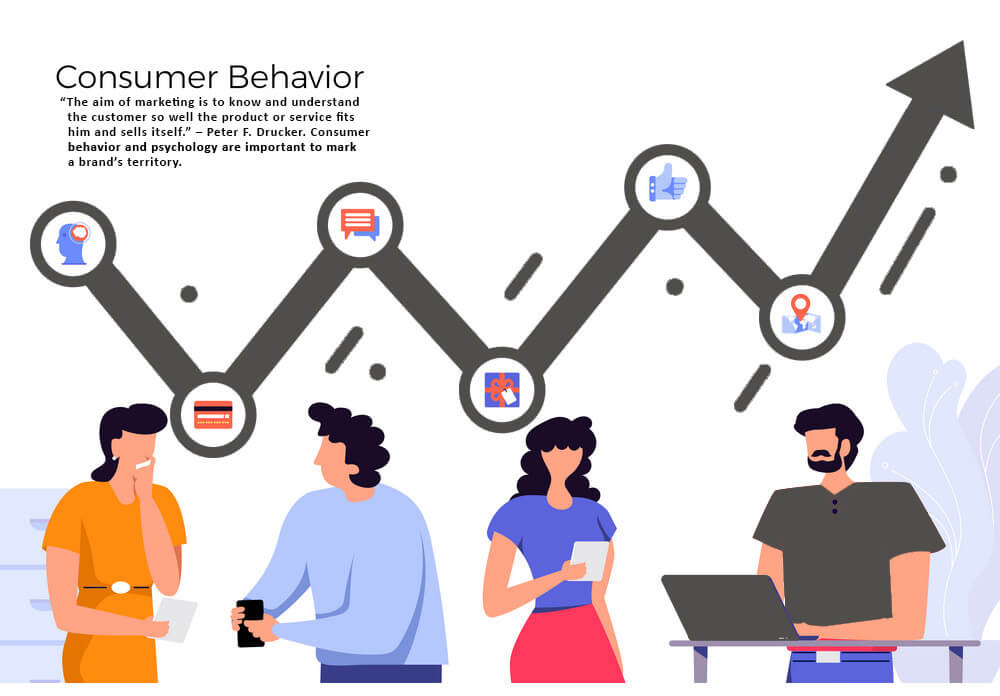As a business owner or marketer, you hold the key to success by understanding the intricate workings of the consumer decision-making process. This process is not just a mere series of steps; it is an art that can be mastered to influence and guide consumers toward purchasing your products or services.
Click here for an in-depth article on consumer behavior!
Why does this matter so much? Well, let’s dive into its importance for businesses like yours. Firstly, recognizing and addressing any barriers or obstacles that may hinder customers from buying from you is crucial. By understanding their thought processes, you can identify pain points and provide solutions that will make them choose your brand over others.
Secondly, tailoring your marketing strategies to align with each stage of the decision-making journey empowers you to meet consumers’ needs head-on. From initial recognition all the way through evaluation and purchase, being there every step of the way ensures that your message resonates with potential buyers at exactly the right moment.
Lastly, effective communication lies at the heart of successful marketing campaigns. By truly comprehending how consumers make decisions, you can craft messages that speak directly to their desires and aspirations. Now let’s embark on an enlightening exploration of these five stages in detail.
Unlocking the Secrets of Consumer Decision-Making
The consumer decision-making process is a fascinating journey that businesses must comprehend to successfully market their products or services. This intricate process encompasses a series of steps that consumers embark on when making purchasing decisions. By delving into these stages, businesses can craft targeted marketing strategies and messages that resonate with their target audience’s needs and preferences.
Why Understanding This Process is Crucial for Businesses:
Grasping the intricacies of the consumer decision-making process is paramount for businesses as it empowers them to anticipate and influence customer behavior. By gaining insights into how consumers make choices, companies can develop impactful marketing campaigns, refine product offerings, and elevate customer satisfaction levels. Furthermore, by identifying potential obstacles or challenges at each stage, businesses can proactively address them and significantly enhance their chances of success.
The Five Stages of the Consumer Decision-Making Process

1. Problem Recognition:
At this initial stage, consumers experience an “aha” moment when they recognize a need or desire for a specific product or service. This realization may be triggered by various factors, such as an existing problem they wish to solve or an exciting opportunity they want to seize upon. For instance, someone might come to the realization that they require a new laptop because their current one has become sluggish and outdated.
2. Information Search:
Once consumers identify a problem or need in step one, they embark on an information-gathering quest in search of viable solutions. They scour different sources like online research platforms, seek recommendations from trusted friends or family members, and read insightful blog posts on relevant websites/forums – all in pursuit of valuable information related to the desired product/service category. In our previous example involving laptops, individuals seeking an upgrade would delve into tech blogs while meticulously comparing specifications on e-commerce websites.
3. Evaluation of Alternatives:
Armed with the knowledge acquired during step two, buyers proceed to evaluate various alternatives that could potentially fulfill their identified needs/wants/desires. They meticulously assess these options based on a range of criteria, such as price, features, quality, and reputation. By weighing the pros and cons of each alternative, consumers narrow down their choices. For instance, a buyer in search of a laptop might compare different brands based on factors like price point, performance capabilities, and customer reviews.
4. Purchase Decision:
Once consumers have thoroughly evaluated the available alternatives in step three, they reach the pivotal moment of making a purchase decision by selecting one product or service over others. This decision is influenced by personal preferences, budget constraints, and brand loyalty – all playing significant roles in shaping the final choice. In our laptop example scenario, the consumer may opt for a specific brand/model that aligns perfectly with their desired specifications while remaining within their budgetary limits.
5. Post-Purchase Behavior:
The final stage encompasses how consumers behave after completing their purchase journey. It involves assessing their satisfaction level with the chosen product/service and determining whether it meets or exceeds expectations set during previous stages. Positive experiences can foster repeat purchases and generate positive word-of-mouth recommendations – invaluable assets for businesses seeking long-term success. Conversely, negative experiences can lead to dissatisfaction and potential loss of future business opportunities.
Understanding each stage of the consumer decision-making process equips businesses with invaluable insights into customers’ thought processes and behaviors throughout their purchasing journey. By tailoring marketing efforts to effectively address each stage’s nuances, companies can heighten customer engagement levels while building trust that ultimately translates into increased sales figures.
Factors Influencing the Consumer Decision-Making Process
To truly excel in marketing, businesses must grasp the intricacies of the consumer decision-making process. But here’s a little secret: it’s not all about rational thinking. There are numerous factors at play that can sway a buyer’s journey, encompassing personal, psychological, and social influences.
1. Personal Factors:
- Different age groups have distinct needs and preferences. For instance, tech-savvy youngsters may gravitate towards cutting-edge products.
- Society norms often shape consumer behavior based on gender. Certain products may be tailored specifically for men or women.
- Purchasing power hinges on income level. Those with higher incomes might splurge on luxury items, while budget-conscious individuals seek affordability.
- Consumers’ lifestyles and interests significantly impact their buying decisions. An active individual might prioritize fitness-related purchases.
2. Psychological Factors:
- Understanding what drives consumers to make a purchase is paramount for businesses seeking success. This could range from fulfilling basic needs to satisfying emotional desires like status or self-esteem.
- How consumers perceive a product or brand holds immense sway over their decision-making process. Positive perceptions breed heightened interest and likelihood of purchase.
- Consumers’ attitudes towards brands or products stem from their beliefs and values—a powerful force guiding them towards one choice over another.
3. Social Factors:
- Cultural background exerts a significant influence on consumer behavior across regions and countries.
- People often seek validation from others when making purchasing decisions—friends, family members, celebrities, and influencers—all serve as reference points for guidance.
- A person’s social class shapes their buying decisions; those from higher classes may favor luxury brands, while lower-class individuals focus more on affordability.
It’s crucial to recognize that these factors affect each stage of the consumer decision-making process differently. For example, personal factors like age or income level may impact problem recognition and evaluation of alternatives, while psychological factors such as motivation and perception can heavily sway the purchase decision stage.
By unraveling these influential forces, businesses can tailor their marketing strategies to effectively target specific consumer segments. Armed with this knowledge, they can craft captivating advertisements, develop products that cater to consumers’ needs and desires, and forge strong brand connections with their target audience.

How Businesses Can Influence the Consumer Decision-Making Process
In today’s competitive market, businesses must possess a deep understanding of the consumer decision-making process in order to thrive. By strategically navigating each stage of this journey, companies can significantly enhance their chances of securing sales and cultivating customer loyalty. Here, we present expert strategies that businesses can employ to influence every crucial step:
1. Recognition of Problems:
- Igniting awareness: Employ powerful marketing techniques such as captivating advertisements, engaging social media campaigns, and compelling content creation to shed light on common problems or needs that your product or service effectively addresses.
- Presenting solutions: Position your offering as the ultimate solution by emphasizing its unique features and benefits that set it apart from alternatives.
2. Search for Information:
- Providing comprehensive details: Ensure potential customers have easy access to detailed information about your product or service through various channels like informative websites, enticing brochures, captivating videos, and authentic customer reviews.
- Harnessing SEO power: Optimize your online presence with relevant keywords related to your industry so that when consumers search for information on products similar to yours, they find you effortlessly.
3. Evaluation of Alternatives:
- Showcasing competitive advantages: Clearly communicate what distinguishes your product from competitors in terms of quality, price point, functionality, or any other key differentiators.
- Tempting incentives: Offer special deals such as exclusive discounts or free trials to entice consumers into choosing your product over others.
4. Making the Purchase Decision:
- Streamlining the buying process: Simplify purchasing by providing multiple payment options (credit card/PayPal) and ensuring a user-friendly checkout experience.
- Leveraging social proof: Showcase positive testimonials from satisfied customers on both your website and social media platforms; this builds trust and confidence among potential buyers.
5. Post-Purchase Behavior:
- Personalized communication is key: Follow up with personalized thank-you emails after purchases, accompanied by additional resources related to their specific purchase (e.g., user guides). This demonstrates your commitment to customer satisfaction even after the sale.
- Encouraging reviews and referrals: Request feedback from customers and incentivize them to leave reviews or refer your product to others. Positive word-of-mouth can wield significant influence over future buying decisions.
By implementing these expert strategies, businesses can effectively guide consumers through the decision-making process, significantly increasing the likelihood of a purchase while fostering long-term customer relationships. Understanding consumer behavior is paramount for effective marketing as it enables businesses to tailor their messaging and offerings precisely according to the needs and desires of their target audience.
Conclusion: The Power of Understanding the Consumer Decision-Making Process
As experts in consumer behavior and marketing, we cannot emphasize enough the importance of understanding how consumers make decisions. It’s a journey that every buyer goes through when considering a purchase, and it holds the key to your success.
- The first stage refers to consumers becoming aware of their need for a product or service. They can find out about it through ads, recommendations, or stumbling upon informative blog posts like this one. Recognition sets off a chain reaction that propels consumers into action.
- The information search stage includes actively seeking out relevant information about potential alternatives. They turn to search engines, read reviews on websites and blogs, and engage with others who have made similar purchases. The more informed they are during this stage, the better equipped they will be to make sound decisions later on.
- Evaluation is one of the most critical stages when buyers carefully assess all available options based on the price, quality, features, and brand reputation. They weigh the pros and cons before narrowing down their choices.
- Once evaluation is complete comes decision making, where consumers finally choose which alternative best meets their needs. This is when the buyer’s journey reaches its climax as they commit to making a purchase.
- The final stage involves reflecting on whether expectations were met and, if so, determining whether future purchases from that same brand are likely. This step highlights how important it is for businesses to consistently deliver exceptional products, services, and customer experiences to foster loyalty among consumers.
In conclusion, the power of understanding this process cannot be overstated. It allows businesses to effectively guide consumers toward informed decisions and ultimately drive sales. So take the time to delve into your target audience’s mindset, anticipate their needs, and craft compelling marketing campaigns that address those needs at every stage of their buyer’s journey. Your efforts will not go unnoticed by savvy consumers who appreciate being understood and catered to throughout their purchasing experience.

